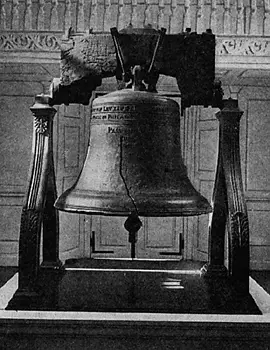 Born
into a farm family, John Adams soon graduated to the law and
moved to Boston, becoming the Massachusetts colony's leading
attorney. In 1764, he married Abigail Smith, who was one of
the most well-informed women of her time.
Born
into a farm family, John Adams soon graduated to the law and
moved to Boston, becoming the Massachusetts colony's leading
attorney. In 1764, he married Abigail Smith, who was one of
the most well-informed women of her time.
 Along
with his cousin Samuel,
John Adams was with the Revolution from its infancy,
beginning with his strong opposition to the Stamp
Act,
which taxed newspapers, legal papers, and other paper items.
Ironically, he defended the British soldiers who fired into
the crowd in the Boston
Massacre.
As a Massachusetts delegate to both the First and Second
Continental Congresses, he argued against any decision short
of independence. He spoke in favor of George
Washington's
being appointed Commander in Chief of the armed forces and
later worked feverishly to bring about an alliance with
France, which was realized after the victory at
Saratoga
in 1778.
Along
with his cousin Samuel,
John Adams was with the Revolution from its infancy,
beginning with his strong opposition to the Stamp
Act,
which taxed newspapers, legal papers, and other paper items.
Ironically, he defended the British soldiers who fired into
the crowd in the Boston
Massacre.
As a Massachusetts delegate to both the First and Second
Continental Congresses, he argued against any decision short
of independence. He spoke in favor of George
Washington's
being appointed Commander in Chief of the armed forces and
later worked feverishly to bring about an alliance with
France, which was realized after the victory at
Saratoga
in 1778.
Other
wartime activities included his writing of the Massachusetts
constitution, the basis for other states' statues, and the
recognition by the Netherlands of an independent America,
along with a loan of about $1,400,000. In 1785, he was named
the first U.S. Ambassador to Great Britain.
 Another
part of these trying times were the Alien and Sedition Acts,
passed by the Federalist majority in Congress. The former
gave the president power to banish or imprison foreigners by
a simple order; the latter made it a crime to criticize the
government. Although Adams never invoked the Alien Acts, he
did have several Jefferson sympathizers arrested on grounds
of sedition.
Another
part of these trying times were the Alien and Sedition Acts,
passed by the Federalist majority in Congress. The former
gave the president power to banish or imprison foreigners by
a simple order; the latter made it a crime to criticize the
government. Although Adams never invoked the Alien Acts, he
did have several Jefferson sympathizers arrested on grounds
of sedition.

 Born
into a farm family, John Adams soon graduated to the law and
moved to Boston, becoming the Massachusetts colony's leading
attorney. In 1764, he married Abigail Smith, who was one of
the most well-informed women of her time.
Born
into a farm family, John Adams soon graduated to the law and
moved to Boston, becoming the Massachusetts colony's leading
attorney. In 1764, he married Abigail Smith, who was one of
the most well-informed women of her time.
 Along
with his cousin
Along
with his cousin  Another
part of these trying times were the Alien and Sedition Acts,
passed by the Federalist majority in Congress. The former
gave the president power to banish or imprison foreigners by
a simple order; the latter made it a crime to criticize the
government. Although Adams never invoked the Alien Acts, he
did have several Jefferson sympathizers arrested on grounds
of sedition.
Another
part of these trying times were the Alien and Sedition Acts,
passed by the Federalist majority in Congress. The former
gave the president power to banish or imprison foreigners by
a simple order; the latter made it a crime to criticize the
government. Although Adams never invoked the Alien Acts, he
did have several Jefferson sympathizers arrested on grounds
of sedition.
